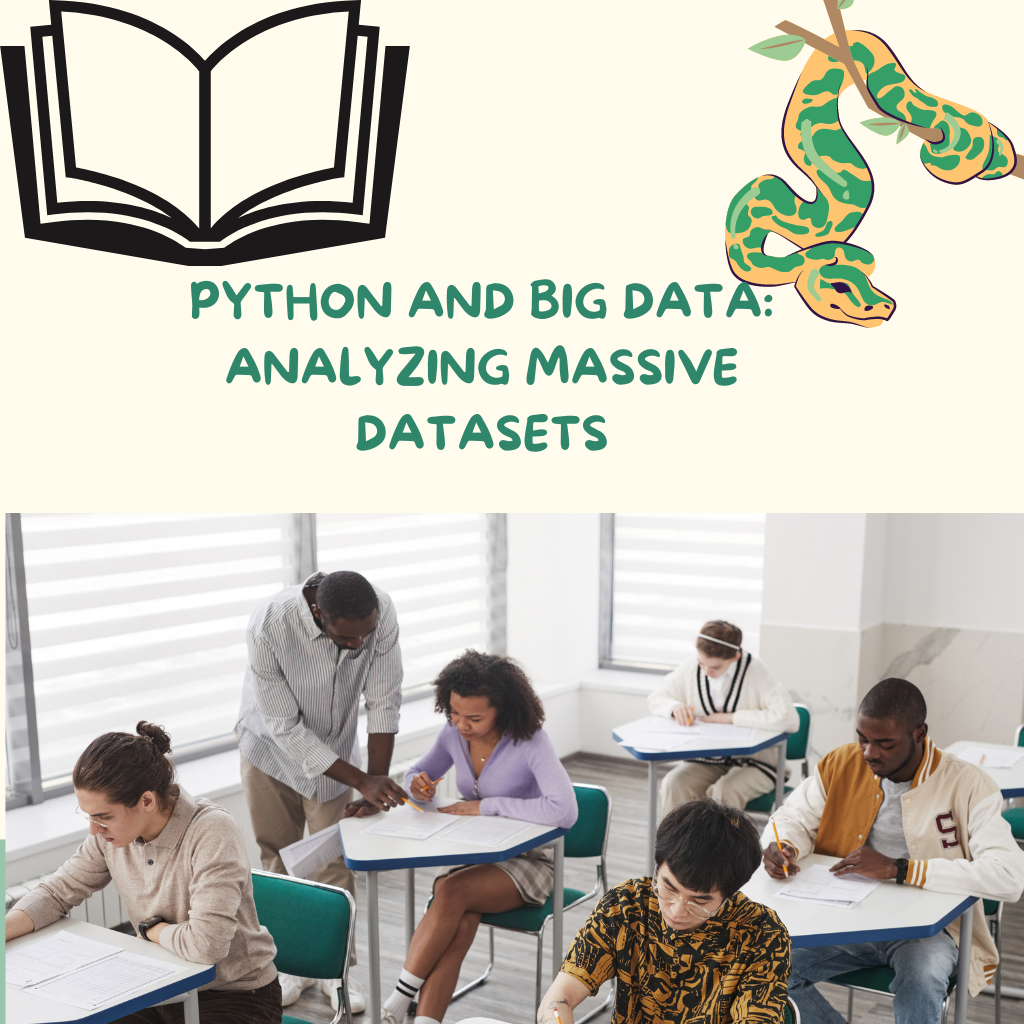Python and Big Data: Analyzing Massive Datasets

Introduction
In the era of information explosion, the need to analyze massive datasets has become more critical than ever. Big Data, characterized by its volume, velocity, and variety, requires powerful tools and languages for effective processing. Python, with its simplicity, versatility, and a rich ecosystem of libraries, has emerged as a key player in the realm of Big Data analytics. This article explores the intersection of Python and Big Data, delving into the tools, techniques, and best practices for analyzing massive datasets.
Understanding Big Data
1. Volume, Velocity, and Variety:
Big Data is characterized by three Vs – Volume, Velocity, and Variety. Volume refers to the sheer size of data, often ranging from terabytes to petabytes. Velocity represents the speed at which data is generated and processed. Variety encompasses the diverse formats of data, including structured, semi-structured, and unstructured data.
2. Challenges in Big Data Analysis:
Analyzing massive datasets poses unique challenges. Traditional databases and tools are often inadequate for handling the scale and complexity of Big Data. Moreover, the need for real-time or near-real-time analysis adds another layer of complexity.
Python and Big Data Tools
1. Apache Hadoop:
Apache Hadoop, a popular open-source framework, is widely used for distributed storage and processing of large datasets. Python integrates seamlessly with Hadoop through libraries like Pydoop and Hadoop Streaming, enabling developers to write MapReduce programs in Python.
2. Apache Spark:
Apache Spark, known for its speed and ease of use, has become a go-to solution for Big Data processing. PySpark, the Python API for Spark, allows developers to leverage the power of Spark using Python. This combination enables the analysis of large datasets in a distributed and fault-tolerant manner.
3. Dask:
Dask is a flexible library that enables parallel computing in Python. It allows developers to build parallel algorithms using familiar APIs from NumPy, pandas, and scikit-learn. Dask is particularly useful for scalable and parallel computing on larger-than-memory datasets.
4. Apache Flink:
Apache Flink is a stream processing framework that excels at real-time data processing. PyFlink provides Python bindings for Flink, allowing developers to build real-time analytics applications using Python.
5. Pandas and NumPy:
While not specifically designed for Big Data, Pandas and NumPy are foundational libraries for data manipulation and analysis in Python. These libraries can be used for preprocessing and analysis on smaller subsets of Big Data before scaling up to distributed frameworks.
Python in Action: Analyzing Massive Datasets
1. Data Ingestion:
The first step in Big Data analysis is data ingestion. Python excels at this stage, with libraries like Pandas and Dask handling data loading from various sources, including databases, CSV files, and APIs.
2. Data Cleaning and Preprocessing:
Pandas and NumPy play a crucial role in cleaning and preprocessing data. Python’s extensive ecosystem of data manipulation tools simplifies tasks such as handling missing values, transforming data types, and normalizing datasets.
3. Exploratory Data Analysis (EDA):
Jupyter Notebooks, a popular tool among data scientists, allows for interactive and iterative data exploration. Python’s Matplotlib and Seaborn facilitate the creation of insightful visualizations, aiding in understanding the characteristics of massive datasets.
4. Machine Learning with scikit-learn:
Python’s scikit-learn library is widely used for machine learning tasks. When dealing with Big Data, distributed machine learning libraries like PySpark MLlib or Dask-ML become essential for scaling algorithms to large datasets.
5. Real-time Analytics:
For real-time analytics, Python can be employed with streaming frameworks like Apache Kafka and Apache Flink. These frameworks enable the processing of data as it is generated, allowing for timely insights and decision-making.
Best Practices in Python for Big Data
1. Use of Distributed Computing:
When dealing with massive datasets, distributed computing frameworks like Apache Spark are indispensable. Python’s PySpark API facilitates the seamless integration of Python with Spark, enabling efficient and scalable data processing.
2. Optimized Data Storage Formats:
Choosing the right data storage format is crucial for performance. Python supports file formats like Parquet and Avro, which are optimized for Big Data analytics. These formats enhance data compression and query performance, especially when dealing with large datasets.
3. Parallel Processing with Dask:
Dask’s ability to parallelize computations makes it a valuable tool for scaling Python-based workflows. Leveraging Dask allows developers to utilize parallel processing on multicore machines or distributed computing environments.
4. Efficient Memory Management:
Optimizing memory usage is essential when working with large datasets. Python’s garbage collection and memory management features, combined with tools like Dask, help in efficiently managing memory and avoiding bottlenecks.
5. Scalable Machine Learning Models:
When applying machine learning to Big Data, the scalability of models becomes paramount. Distributed machine learning libraries compatible with Python, such as PySpark MLlib and Dask-ML, enable the training of models on large datasets distributed across clusters.
Case Study: Analyzing Social Media Data
Let’s consider a practical case study to illustrate the application of Python in analyzing massive datasets. Suppose we have a vast dataset from various social media platforms containing user interactions, comments, and sentiments. The goal is to perform sentiment analysis at scale.
- Data Ingestion:
- Use Pandas or Dask to load the social media data into a distributed environment.
- Data Cleaning and Preprocessing:
- Utilize Pandas or Dask for cleaning tasks, handling missing values, and transforming the data into a suitable format.
- Exploratory Data Analysis:
- Employ Jupyter Notebooks with Matplotlib and Seaborn for visualizing trends, sentiments, and user interactions.
- Distributed Sentiment Analysis:
- Leverage PySpark MLlib or Dask-ML for building and deploying sentiment analysis models at scale.
- Real-time Analytics:
- Implement real-time analytics using Apache Kafka for data streaming and Apache Flink for processing and analyzing sentiments as they are generated.
Conclusion
In the realm of Big Data analytics, Python stands as a versatile and powerful language, providing developers with the tools and libraries needed to tackle massive datasets. For individuals aspiring to harness the potential of Python in Big Data analytics, enrolling in a Python Training Course in Roorkee, Indore, Lucknow, Meerut, Noida, or other cities in India becomes a strategic step.
From distributed computing with Apache Spark and PySpark to scalable machine learning with Dask-ML and PySpark MLlib, Python’s ecosystem addresses the unique challenges posed by Big Data. A Python training course tailored to these cities offers an opportunity for learners to delve into the intricacies of Python’s application in Big Data analytics. Participants can gain hands-on experience and practical insights, preparing them to tackle real-world scenarios in the dynamic field of data analytics.





